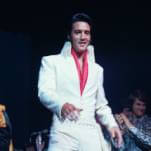Mark Kurlansky: 1968: The Year That Rocked The World

"They were demanding better food and more dances" doesn't rank up there with Yippies mobbing the Democratic National Convention or Polish dissidents sneaking news to Radio Free Europe, but the reason behind the hundreds-strong occupation of a Brooklyn junior-high school signaled the stormy weather of 1968 just the same. Taking a break from the pointillist microhistory of his books Salt and Cod, author Mark Kurlansky eyes one of the 20th century's most notorious years in 1968, a survey of the disparate yet intertwined movements afoot during a period of ceaseless turmoil. Tacking across the planet with a mind for chronology, the book opens with 1968's first week, touching on increasing friction in Vietnam, O.J. Simpson in the Rose Bowl, hemlines, Bob Dylan's return from a motorcycle wreck, the prophesied rise of personal computing, Stokely Carmichael's standing in the Black Power movement, and troubled leadership in America, France, Spain, Portugal, the Middle East, and Czechoslovakia. That's a lot to draw from one week, but the opening introduces the strategy of a book that uses overwhelming swirl to great advantage. With no readily apparent organizational method, 1968 zooms in and pans out in fitful movements that both resist and indulge the luxury of context. The underlying thesis traces 1968's worldwide protest surge to four major factors: the inventive strategies of the American civil-rights movement, an unprecedented generation gap, shared dismay over the Vietnam War, and the rise of television as an immediate, far-reaching means for exposure. From there, the book chronicles a vast array of friction and conflict, focusing largely on the era's storied rash of student uprisings. At home, Students for a Democratic Society ignited movements that culminated in the full-scale takeover of Columbia University; abroad, French students rocked Paris to its core, while young Czechoslovakians rallied behind Alexander Dubcek, whose relative tolerance of a free press and cultural progressivism incited an invasion by his Communist overseers in the Soviet Union. Alongside the student movement, the book surveys the newly militarizing sweep of Black Power, revolutionary chic in Cuba, massacre in Mexico, the first real TV presence of feminism, and the rise of modern-day Republicanism behind Richard Nixon. Kurlansky rarely takes the upper hand over his subjects, favoring an observational stance that lets events unfurl and link together by proximity. His approach reads like mere cataloguing in parts, but it also helps mimic the rebellious intensity, as well as the increasingly recognized ideological void, that defined a year when action took a defiant bow on center stage.





![HBO teases new Euphoria, Larry David, and much more in 2026 sizzle reel [Updated]](https://img.pastemagazine.com/wp-content/avuploads/2025/12/12100344/MixCollage-12-Dec-2025-09-56-AM-9137.jpg)


































